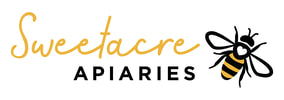Well I have made it around to all my yards and I really do like what I have seen. 2 of my yards losses where high bringing down my percentage. But taking those 2 yards into account I had over 80% success, ignoring those 2 it was over 90%. Around here I think it was as good of a winter as we could get in the Shuswap. It was nice and mild and we really didn't get a real cold snap until January which was lows of -20 C for 7-10 days. Another bonus regarding this winter is that I believe that at least 1 day every month there was a good opportunity for a cleansing flight.
I think the 2 things that I need to learn regarding this winter is a. take your losses in the fall, b.know the numbers game. Both of these I already know in my head, but they have to be reflected more in my practice.
The 2 yards that I had my biggest losses I had concerns about last fall. There was a poor honeyflow for the bees to work and I the hive hives where lacking vigor. It's hard to explain that in detail, but when I was looking at them last fall I didn't walk away feeling good about them. Also the population of some of the hives where full but not bursting. I believe what I should have done with them was simply amalgamate anything that was not bursting and let the Q's figure it out. Also I could have fed 3 or 4 pollen patties to them after the honey was pulled just to keep the Q's laying hard for a few more weeks giving the winter bees lot's of protein and helping their numbers.
The numbers game is fun! Let's say I want 150 healthy colonies for next spring. I have to consider winter loss and also fall issues like the paragraph above, or hives swarming, or Q's failing (heaven forbid they get rolled, or blown out by the bee blower!). So if I want 150 colonies in the spring let's work backwards through my season. 20% winter loss, so I need 180 into the winter. 10% flunkies, swarms, various Q issues that will be dealt with before you go into winter. So if I want to have 150 healthy strong colonies in 2013 I need to reach 180+10%=198 colonies for the summer of 2012.
That is one reason why I always encourage beginners to start with at least a couple hives and always make a few nuc's for themselves to have handy. I think we need to remember that in a feral environment bees are forever swarming, superceding mating, swarming, swarming, mating. I used to know the average life of a feral colony, I can't remember now but it's measured in months
I think the 2 things that I need to learn regarding this winter is a. take your losses in the fall, b.know the numbers game. Both of these I already know in my head, but they have to be reflected more in my practice.
The 2 yards that I had my biggest losses I had concerns about last fall. There was a poor honeyflow for the bees to work and I the hive hives where lacking vigor. It's hard to explain that in detail, but when I was looking at them last fall I didn't walk away feeling good about them. Also the population of some of the hives where full but not bursting. I believe what I should have done with them was simply amalgamate anything that was not bursting and let the Q's figure it out. Also I could have fed 3 or 4 pollen patties to them after the honey was pulled just to keep the Q's laying hard for a few more weeks giving the winter bees lot's of protein and helping their numbers.
The numbers game is fun! Let's say I want 150 healthy colonies for next spring. I have to consider winter loss and also fall issues like the paragraph above, or hives swarming, or Q's failing (heaven forbid they get rolled, or blown out by the bee blower!). So if I want 150 colonies in the spring let's work backwards through my season. 20% winter loss, so I need 180 into the winter. 10% flunkies, swarms, various Q issues that will be dealt with before you go into winter. So if I want to have 150 healthy strong colonies in 2013 I need to reach 180+10%=198 colonies for the summer of 2012.
That is one reason why I always encourage beginners to start with at least a couple hives and always make a few nuc's for themselves to have handy. I think we need to remember that in a feral environment bees are forever swarming, superceding mating, swarming, swarming, mating. I used to know the average life of a feral colony, I can't remember now but it's measured in months

 RSS Feed
RSS Feed
